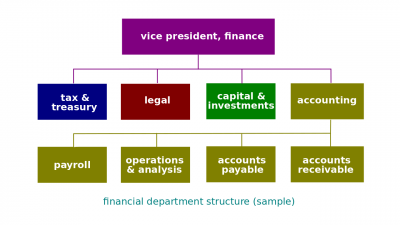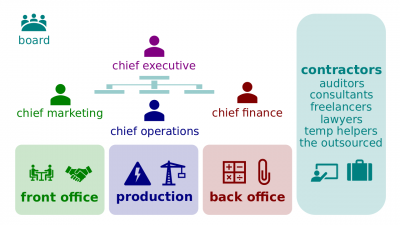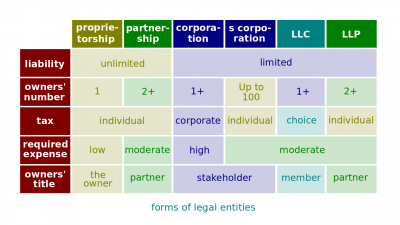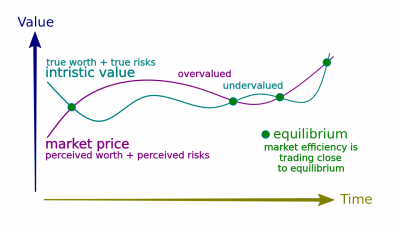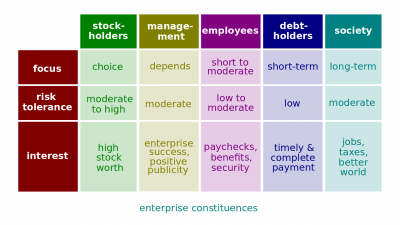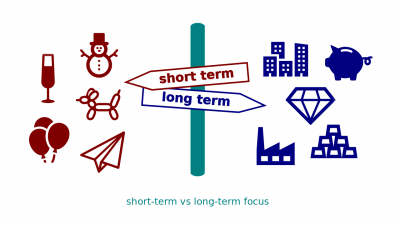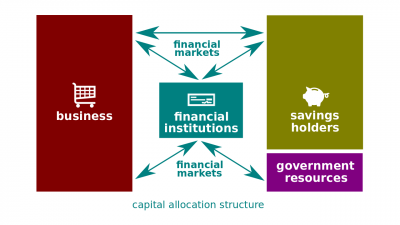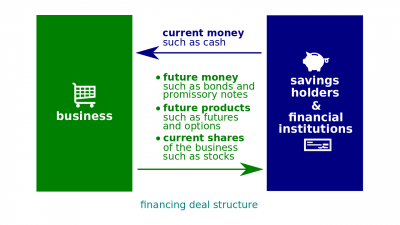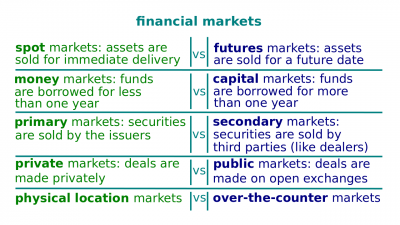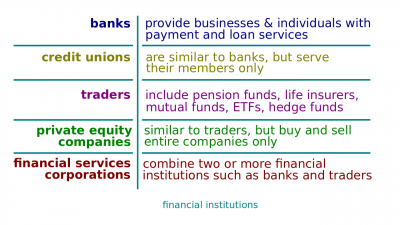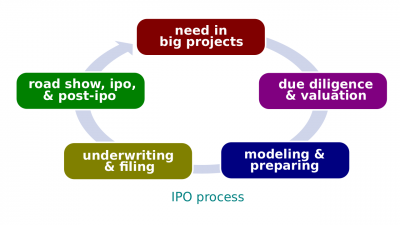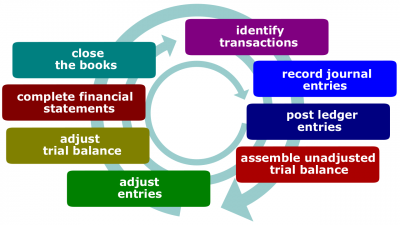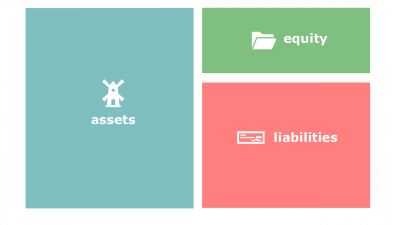Fundamentals of Financial Management by Eugene F. Brigham and Joel F. Houston (15th edition)
Fundamentals of Financial Management by Eugene F. Brigham and Joel F. Houston (15th edition) is the 15th edition of the textbook written by Eugene F. Brigham and Joel F. Houston for financial management studies.
Contents
- 1 Introduction To Financial Management
- 2 Financial Markets and Institutions
- 3 Financial Statements, Cash Flow and Taxes
- 4 Analysis of Financial Statements
- 5 Time Value of Money
- 6 Interest Rates
- 7 Bonds and Their Valuation
- 8 Risk and Rates of Return
- 9 Stocks and Their Valuation
- 10 The Cost of Capital
- 11 The Basics of Capital Budgeting
- 12 Cash Flow Estimations and Risk Analysis
- 13 Real Options and other topics in Capital Budgeting
- 14 Capital Structure and Leverage
- 15 Derivatives and Risk Management
- 16 Multinational Financial Management
- 17 Hybrid Financing: Preferred Stock, Leasing, Warrants, and Convertibles
- 18 Mergers and Acquisitions
Introduction To Financial Management
- Sarbanes-Oxley Act. A law passed by Congress that requires the CEO and CFO to certify that their firm's financial statements are accurate.
- Proprietorship. An unincorporated business owned by one individual.
- Partnership. An unincorporated business owned by two or more persons.
- Corporation. A legal entity created by a state, separate and distinct from its owners and managers, having unlimited life, easy transferability of ownership, and limited liability.
- S corporation. A special designation that allows small businesses that meet qualifications to be taxed as if they were a proprietorship or a partnership rather than a corporation.
- Limited liability company (LLC). A popular type of organization that is a hybrid between a partnership and a corporation.
- Limited liability partnership (LLP). Similar to an LLC but used for professional firms in the fields of accounting, law, and architecture. It provides personal asset protection from business debts and liabilities but is taxed as a partnership.
- Intrinsic value. An estimate of a stock's "true" value based on accurate risk and return data. The intrinsic value can be estimated, but not measured precisely.
- Market price. The stock value based on perceived but possibly incorrect information as seen by the marginal investor.
- Marginal investor. An investor whose views determine the actual stock price.
- Equilibrium. The situation in which the actual market price equals the intrinsic value, so investors are indifferent between buying and selling a stock.
- Corporate governance. Establishment of rules and practices by Board of Directors to ensure that managers act in shareholders' interests while balancing the needs of other key constituencies.
- Corporate raiders. Individuals who target corporations for takeover because they are undervalued.
- Hostile takeover. The acquisition of a company over the opposition of its management.
- Shareholder wealth maximization. The primary financial goal for managers of publicly owned companies implies that decisions should be made to maximize the long-run value of the firm's common stock.
Financial Markets and Institutions
- Spot markets. The markets in which assets are bought or sold for “on-the-spot” delivery.
- Futures markets. The markets in which participants agree today to buy or sell an asset at some future date.
- Money markets. The financial markets in which funds are borrowed or loaned for short periods (less than one year).
- Capital markets. The financial markets for stocks and for intermediate or long-term debt (one year or longer). The financial markets for stocks and for intermediate- or long-term debt (one year or longer).
- Primary markets. Markets in which corporations raise capital by issuing new securities.
- Secondary markets. Markets in which securities and other financial assets are traded among investors after they have been issued by corporations.
- Private markets. Markets in which transactions are worked out directly between two or more parties.
- Public markets. Markets in which standardized contracts are traded on organized exchanges.
- Derivatives. Any financial asset whose value is derived from the value of some other “underlying” asset.
- Investment bank. An organization that underwrites and distributes new investment securities and helps businesses obtain financing.
- Commercial bank. The traditional department store of finance serving a variety of savers and borrowers.
- Financial services corporation. A firm that offers a wide range of financial services, including investment banking, brokerage operations, insurance, and commercial banking.
- Mutual funds. Organizations that pool investor funds to purchase financial instruments and thus reduce risks through diversification.
- Money market funds. Mutual funds that invest in short-term, low-risk securities and allow investors to write checks against their accounts.
- Physical location exchange. Formal organizations having tangible physical locations that conduct auction markets in designated ("listed") securities.
- Over-the-counter market (OTC market). A large collection of brokers and dealers, connected electronically by telephones and computers, that provides for trading in unlisted securities.
- Dealer markets. Include all facilities that are needed to conduct security transactions not conducted on the physical location exchanges.
- Closely held corporation. A corporation that is owned by a few individuals who are typically associated with the firm's management.
- Publicly owned corporations. A corporation that is owned by a relatively large number of individuals who are not actively involved in the firm's management.
- Going public. The act of selling stock to the public at large by a closely held corporation or its principal stockholders.
- Initial public offering market (IPO market). The market for stocks of companies that are in the process of going public.
Financial Statements, Cash Flow and Taxes
- Annual report. A report issued annually by a corporation to its stockholders. It contains basic financial statements as well as management's analysis of the firm's past operations and future prospects.
- Stockholders' equity. It represents the amount that stockholders paid the company when shares were purchased and the amount of earnings the company has retained since its origination.
- Retained earnings. They represent the cumulative total of all earnings kept by the company during its life.
- Working capital. Current assets.
- Net working capital. Current assets minus current liabilities.
- Net operating working capital. Operating current assets minus operating current liabilities.
- Income statements. Reports summarizing a firm's revenues, expenses, and profits during a reporting period, generally a quarter or a year.
- Operating income. Earnings from operations before interest and taxes (i.e., EBIT).
- Depreciation. The charge to reflect the cost of assets depleted in the production process. Depreciation is not a cash outlay.
- Amortization. A noncash charge similar to depreciation except that it represents a decline in value of intangible assets.
- EBITDA. An acronym for earnings before interest, taxes, depreciation, and amortization.
- Statement of cash flows. A report that shows how items that affect the balance sheet and income statement affect the firm's cash flows.
- Statement of stockholders' equity. A statement that shows by how much a firm's equity changed during the year and why this change occurred.
- Free cash flow (FCF). The amount of cash that could be withdrawn without harming a firm's ability to operate and to produce future cash flows.
- Net operating profit after taxes (NOPAT). The profit a company would generate if it had no debt and held only operating assets.
- Market Value Added. The excess of the market value of equity over its book value.
- Economic Value Added (EVA). Excess of NOPAT over capital costs.
- Progressive. Excess of NOPAT over capital costs.
- Marginal tax rate. The tax rate applicable to the last unit of a person's income.
- Average tax rate. Taxes paid divided by taxable income.
- Capital gain. The profit from the sale of a capital asset for more than its purchase price.
- Capital loss. The loss from the sale of a capital asset for less than its purchase price.
- Traditional IRAs. Individual retirement arrangements in which qualified contributions are tax deductible and income and capital gains on investments within the account are not taxed until the money is withdrawn after age 59½.
- Roth IRAs. Individual retirement arrangements in which contributions are not tax deductible but the future income and capital gains within these accounts are not taxed if the money is withdrawn after age 59½.
- Alternative minimum tax (AMT). Created by Congress to make it more difficult for wealthy individuals to avoid paying taxes through the use of various deductions.
- Carryback. Ordinary corporate operating losses can be carried backward for 2 years and carried forward for 20 years to offset taxable income in a given year.
- Carryforward. Ordinary corporate operating losses can be carried backward for 2 years and carried forward for 20 years to offset taxable income in a given year.
- S corporation. A small corporation that, under Subchapter S of the Internal Revenue Code, elects to be taxed as a proprietorship or a partnership yet retains limited liability and other benefits of the corporate form of organization.
Analysis of Financial Statements
- Liquid asset. An asset that can be converted to cash quickly without having to reduce the asset's price very much.
- Liquidity ratios. Ratios that show the relationship of a firm's cash and other current assets to its current liabilities.
- Current ratio. This ratio is calculated by dividing current assets by current liabilities. It indicates the extent to which current liabilities are covered by those assets expected to be converted to cash in the near future.
- Quick ratio (acid test ratio). This ratio is calculated by deducting inventories from current assets and then dividing the remainder by current liabilities.
- Asset management ratios. A set of ratios that measure how effectively a firm is managing its assets.
- Inventory turnover ratio. This ratio is calculated by dividing sales by inventories. It indicates how many times inventory is turned over during the year.
- Days sales outstanding ratio (DSO ratio). This ratio is calculated by dividing accounts receivable by average sales per day. It indicates the average length of time the firm must wait after making a sale before it receives cash.
- Fixed assets turnover ratio. The ratio of sales to net fixed assets. It measures how effectively the firm uses its plant and equipment.
- Total assets turnover ratio. This ratio is calculated by dividing sales by total assets. It measures how effectively the firm uses its total assets.
- Debt management ratios. A set of ratios that measure how effectively a firm manages its debt.
- Total debt to total capital. The ratio of total debt to total capital; it measures the percentage of the firm's capital provided by debtholders.
- Times-interest-earned ratio (TIE ratio). The ratio of earnings before interest and taxes EBIT to interest charges; a measure of the firm's ability to meet its annual interest payments.
- Profitability ratio. A group of ratios that show the combined effects of liquidity, asset management, and debt on operating results.
- Operating margin. This ratio measures operating income, or EBIT, per dollar of sales; it is calculated by dividing operating income by sales.
- Profit margin. This ratio measures net income per dollar of sales and is calculated by dividing net income by sales.
- Return on total assets (ROA). The ratio of net income to total assets; it measures the rate of return on the firm's assets.
- Return on invested capital (ROIC). The ratio of after-tax operating income to total invested capital; it measures the total return that the company has provided for its investors.
- Basic earning power (BEP). This ratio indicates the ability of the firm's assets to generate operating income; it is calculated by dividing EBIT by total assets.
- Market value ratios. Ratios that relate the firm's stock price to its earnings and book value per share.
- Price/earnings ratio (P/E ratio). The ratio of the price per share to earnings per share; shows the dollar amount investors will pay for $1 of current earnings.
- Market/book ratio (M/B ratio). The ratio of a stock's market price to its book value.
- Enterprise value/EBITDA ratio (EV/EBITDA ratio). The ratio of a stock's market price to its book value.
- DuPont equation. A formula that shows that the rate of return on equity can be found as the product of profit margin, total assets turnover, and the equity multiplier. It shows the relationships among asset management, debt management, and profitability ratios.
- Benchmarking. The process of comparing a particular company with a subset of top competitors in its industry.
- Trend analysis. An analysis of a firm's financial ratios over time; used to estimate the likelihood of improvement or deterioration in its financial condition.
- "Window dressing" technique. Techniques employed by firms to make their financial statements look better than they really are.
Time Value of Money
- Time line. An important tool used in time value analysis; it is a graphical representation used to show the timing of cash flows.
- Future value. The amount to which a cash flow or series of cash flows will grow over a given period of time when compounded at a given interest rate.
- Present value (PV). The value today of a future cash flow or series of cash flows.
- Compounding. The arithmetic process of determining the final value of a cash flow or series of cash flows when compound interest is applied.
- Compound interest. Occurs when interest is earned on prior periods' interest.
- Simple interest. Occurs when interest is not earned on interest.
- Opportunity cost. The rate of return you could earn on an alternative investment of similar risk.
- Discounting. The process of finding the present value of a cash flow or a series of cash flows; discounting is the reverse of compounding.
- Annuity. A series of equal payments at fixed intervals for a specified number of periods.
- Ordinary annuity (differed annuity). An annuity whose payments occur at the end of each period.
- Annuity due. An annuity whose payments occur at the beginning of each period.
- Future value of annuity, FVAN. The future value of an annuity over N periods.
- Present value of annuity, PVAN. The present value of an annuity of N periods.
- Perpetuity. A stream of equal payments at fixed intervals expected to continue forever.
- Uneven cash flows (nonconstant cash flows). A series of cash flows where the amount varies from one period to the next.
- Payment (PMT). This term designates equal cash flows coming at regular intervals.
- Cash flow, CFt. This term designates a cash flow that's not part of an annuity.
- Annual compounding. The arithmetic process of determining the final value of a cash flow or series of cash flows when interest is added once a year.
- Semmiannual compounding. The arithmetic process of determining the final value of a cash flow or series of cash flows when interest is added twice a year.
- Nominal interest rate (APR), INOM. The contracted interest rate.
- Effective annual rate (equivalent annual rate), EFF% or EAR. The annual rate of interest actually being earned, as opposed to the quoted rate.
- Amortized loan. A loan that is repaid in equal payments over its life.
- Amortization schedule. A table showing precisely how a loan will be repaid. It gives the required payment on each payment date and a breakdown of the payment, showing how much is interest and how much is repayment of principal.
Interest Rates
- Production opportunity. The investment opportunities in productive (cash generating) assets.
- Time preference for consumption. The preferences of consumers for current consumption as opposed to saving for future consumption.
- Risk. In a financial market context, the chance that an investment will provide a low or negative return.
- Inflation. The amount by which prices increase over time.
- Real risk-free rate of interest, r*. The rate of interest that would exist on default free U.S. Treasury securities if no inflation were expected.
- Nominal risk-free rate (quoted risk-free rate), r/RF. The rate of interest on a security that is free of all risk; rRF is proxied by the T-bill rate or the T-bond rate; rRF includes an inflation premium.
- Inflation premium. A premium equal to expected inflation that investors add to the real risk-free rate of return.
- Default risk premium (DRP). The difference between the interest rate on a U.S. Treasury bond and a corporate bond of equal maturity and marketability.
- Liquidity premium (LP). A premium added to the equilibrium interest rate on a security if that security cannot be converted to cash on short notice and at close to its “fair market value.
- Interest rate risk. The risk of capital losses to which investors are exposed because of changing interest rates.
- Maturity risk premium (MRP). A premium that reflects interest rate risk.
- Reinvestment rate risk. The risk that a decline in interest rates will lead to lower income when bonds mature and funds are reinvested.
- Term structure of interest rate. The relationship between bond yields and maturities.
- Yield curve. A graph showing the relationship between bond yields and maturities.
- Nominal yield curve. An upward-sloping yield curve.
- Inverted yield curve (abdominal yield curve). A downward-sloping yield curve.
- Humped yield curve. A yield curve where interest rates on intermediate-term maturities are higher than rates on both short and longterm maturities.
- Pure expectations theory. A theory that states that the shape of the yield curve depends on investors' expectations about future interest rates.
- Foreign trade deficit. The situation that exists when a country imports more than it exports.
Bonds and Their Valuation
- Bond. A long-term debt instrument.
- Treasury bond. Bonds issued by the United States Federal Government, sometimes referred to as government bonds.
- Corporate bonds. Bonds issued by corporations.
- Municipal bonds. Bonds issued by state and local governments.
- Foreign bonds. Bonds issued by foreign governments or by foreign corporations.
- Par value. The face value of a bond.
- Coupon payment. The specified number of dollars of interest paid each year.
- Coupon interest rate. The stated annual interest rate on a bond.
- Fixed rate bonds. Bonds whose interest rate is fixed for their entire life.
- Floating rate bonds. Bonds whose interest rate fluctuates with shifts in the general level of interest rates.
- Zero coupon bonds. Bonds that pay no annual interest but are sold at a discount below par, thus compensating investors in the form of capital appreciation.
- Original issue discount bond (OID bond). Any bond originally offered at a price below its par value.
- Maturity date. A specified date on which the par value of a bond must be repaid.
- Original maturity. The number of years to maturity at the time a bond is issued.
- Call provision. A provision in a bond contract that gives the issuer the right to redeem the bonds under specified terms prior to the normal maturity date.
- Sinking fund provision. A provision in a bond contract that requires the issuer to retire a portion of the bond issue each year.
- Convertible bonds. Bonds that are exchangeable at the option of the holder for the issuing firm's common stock.
- Warrants. Long-term options to buy a stated number of shares of common stock at a specified price.
- Putable bonds. Bonds with a provision that allows investors to sell them back to the company prior to maturity at a prearranged price.
- Income bond. A bond that pays interest only if it is earned.
- Index bond (purchasing power bond). A bond that has interest payments based on an inflation index so as to protect the holder from inflation.
- Discount bond. A bond that sells below its par value; occurs whenever the going rate of interest is above the coupon rate.
- Premium bond. A bond that sells above its par value; occurs whenever the going rate of interest is below the coupon rate.
- Yield to maturity. The rate of return earned on a bond if it is held to maturity.
- Yield to call. The rate of return earned on a bond when it is called before its maturity date.
- Price risk (interest rate risk). The risk of a decline in a bond's price due to an increase in interest rates.
- Investment risk. The risk that a decline in interest rates will lead to a decline in income from a bond portfolio.
- Investment horizon. The period of time an investor plans to hold a particular investment.
- Duration. The weighted average of the time it takes to receive each of the bond's cash flows.
- Mortgage bond. A bond backed by fixed assets. First mortgage bonds are senior in priority to claims of second mortgage bonds.
- Indenture. A formal agreement between the issuer and the bondholders.
- Debenture. A long-term bond that is not secured by a mortgage on specific property.
- Subordinate debenture. Bonds having a claim on assets only after the senior debt has been paid in full in the event of liquidation.
- Investment-grade bonds. Bonds rated triple-B or higher; many banks and other institutional investors are permitted by law to hold only investment-grade bonds.
- Junk bonds. High-risk, high-yield bonds.
Risk and Rates of Return
- Risk. The chance that some unfavorable event will occur.
- Stand-alone risk. The risk an investor would face if he or she held only one asset.
- Expected rate of return, r. The rate of return expected to be realized from an investment; the weighted average of the probability distribution of possible results.
- Standard deviation. A statistical measure of the variability of a set of observations.
- Coefficient of variation (CV). The standardized measure of the risk per unit of return; calculated as the standard deviation divided by the expected return.
- Sharp ratio. A measure of standalone risk that compares the asset's realized excess return to its standard deviation over a specified period. An investment with a higher ratio has performed better than one with a lower ratio.
- Risk aversion. Risk-averse investors dislike risk and require higher rates of return as an inducement to buy riskier securities.
- Risk premium (RP). The difference between the expected rate of return on a given risky asset and that on a less risky asset.
- Capital Asset Pricing Model (CAPM). A model based on the proposition that any stock's required rate of return is equal to the risk-free rate of return plus a risk premium that reflects only the risk remaining after diversification.
- Expected return on a portfolio. The weighted average of the expected returns on the assets held in the portfolio.
- Realized rate of return, r. Returns that were actually earned during some past period. Actual returns (r) usually turn out to be different from expected returns (r) except for riskless assets.
- Correlation. The tendency of two variables to move together.
- Correlation coefficient, r. A measure of the degree of relationship between two variables.
- Diversifiable risk. That part of a security's risk associated with random events; it can be eliminated by proper diversification. This risk is also known as companyspecific, or unsystematic, risk.
- Market risk. The risk that remains in a portfolio after diversification has eliminated all company-specific risk. This risk is also known as nondiversifiable or systematic or beta risk.
- Market portfolio. A portfolio consisting of all stocks.
- Relevant risk. The risk that remains once a stock is in a diversified portfolio is its contribution to the portfolio's market risk. It is measured by the extent to which the stock moves up or down with the market.
- Beta coefficient, b. A metric that shows the extent to which a given stock's returns move up and down with the stock market. Beta measures market risk.
- Average stock's beta, bA. By definition, bA 5 1 because an average-risk stock is one that tends to move up and down in step with the general market.
- Market risk premium, RPM. The additional return over the risk-free rate needed to compensate investors for assuming an average amount of risk.
- Security market line equation (SML equation). An equation that shows the relationship between risk as measured by beta and the required rates of return on individual securities.
Stocks and Their Valuation
- Proxy. A document giving one person the authority to act for another, typically the power to vote shares of common stock.
- Proxy fight. An attempt by a person or group to gain control of a firm by getting its stockholders to grant that person or group the authority to vote its shares to replace the current management.
- Takeover. An action whereby a person or group succeeds in ousting a firm's management and taking control of the company.
- Preemptive right. A provision in the corporate charter or bylaws that gives common stockholders the right to purchase on a pro rata basis new issues of common stock (or convertible securities).
- Classified stock. Common stock that is given a special designation such as Class A or Class B to meet special needs of the company.
- Founders' shares. Stock owned by the firm's founders that enables them to maintain control over the company without having to own a majority of stock.
- Marginal investor. A representative investor whose actions reflect the beliefs of those people who are currently trading a stock. It is the marginal investor who determines a stock's price.
- Market price, P. The price at which a stock sells in the market.
- Growth rate, g. The expected rate of growth in dividends per share.
- Required rate of return, rs. The minimum rate of return on a common stock that a stockholder considers acceptable.
- Expected rate of return, r⁄s. The rate of return on a common stock that a stockholder expects to receive in the future.
- Actual rate of return (realized rate of return), rs. The rate of return on a common stock actually received by stockholders in some past period;rs may be greater or less than r⁄s and/or rs.
- Dividend yield. The expected dividend divided by the current price of a share of stock.
- Capital gains yield. The capital gain during a given year divided by the beginning price.
- Expected total return. The sum of the expected dividend yield and the expected capital gains yield.
- Constant Growth Model (Gordon Model). Used to find the value of a constant growth stock.
- Supernormal growth (nonconstant growth). The part of the firm's life cycle in which it grows much faster than the economy as a whole.
- Horizon date (terminal date). The date when the growth rate becomes constant. At this date, it is no longer necessary to forecast the individual dividends.
- Horizon value (continuing value). The value at the horizon date of all dividends expected thereafter.
- Corporate Valuation Model. A valuation model used as an alternative to the discounted dividend model to determine a firm's value, especially one with no history of dividends, or the value of a division of a larger firm. The corporate model first calculates the firm's free cash flows, then finds their present values to determine the firm's value.
- Equilibrium. The condition under which the expected return on a security is just equal to its required return, r⁄i 5 ri. Also, P0 5 P⁄0, and the price is stable.
The Cost of Capital
- Target capital structure. The mix of debt, preferred stock, and common equity the firm plans to raise to fund its future projects.
- Capital components. One of the types of capital used by firms to raise funds.
- Weighted average cost of capital (WACC). A weighted average of the component costs of debt, preferred stock, and common equity.
- Before-tax cost of debt, rd. The interest rate the firm must pay on new debt.
- After-tax cost of debt, rd(12T). The relevant cost of new debt, taking into account the tax deductibility of interest; used to calculate the WACC.
- Cost of preferred stock, rp. The rate of return investors require on the firm's preferred stock; rp is calculated as the preferred dividend, Dp, divided by the current price, Pp.
- Cost of retained earnings, rs. The rate of return required by stockholders on a firm's common stock.
- Cost of new common stock, re. The cost of external equity; based on the cost of retained earnings, but increased for flotation costs necessary to issue new common stock.
- Flotation cost, F. The percentage cost of issuing new common stock.
- Flotation cost adjustment. The amount that must be added to rs to account for flotation costs to find re.
- Retained earnings breakpoint. The amount of capital raised beyond which new common stock must be issued.
The Basics of Capital Budgeting
- Capital budgeting. The process of planning expenditures on assets with cash flows that are expected to extend beyond 1 year.
- Strategic business plan. A long-run plan that outlines in broad terms the firm's basic strategy for the next 5 to 10 years.
- Net present value (NPV). A method of ranking investment proposals using the NPV, which is equal to the present value of the project's free cash flows discounted at the cost of capital.
- Independent projects. Projects with cash flows that are not affected by the acceptance or nonacceptance of other projects.
- Mutually exclusive projects. A set of projects where only one can be accepted.
- Internal rate of return (IRR). The discount rate that forces a project's NPV to equal zero.
- Multiple IRRs. The situation where a project has two or more IRRs.
- Modified IRR (MIRR). The discount rate at which the present value of a project's cost is equal to the present value of its terminal value, where the terminal value is found as the sum of the future values of the cash inflows, compounded at the firm's cost of capital.
- Net present value profile. A graph showing the relationship between a project's NPV and the firm's cost of capital.
- Crossover rate. The cost of capital at which the NPV profiles of two projects cross and, thus, at which the projects' NPVs are equal.
- Payback period. The length of time required for an investment's cash flows to cover its cost.
- Discounted payback. The length of time required for an investment's cash flows, discounted at the investment's cost of capital, to cover its cost.
Cash Flow Estimations and Risk Analysis
- Incremental cash flows. Cash flows that will occur if and only if the firm takes on a project.
- Sunk cost. A cash outlay that has already been incurred and that cannot be recovered regardless of whether the project is accepted or rejected.
- Opportunity costs. The best return that could be earned on assets the firm already owns if those assets are not used for the new project.
- Externalities. Effects on the firm or the environment that are not reflected in the project's cash flows.
- Cannibalization. The situation when a new project reduces cash flows that the firm would otherwise have had.
- Stand-alone risk. The risk an asset would have if it were a firm's only asset and if investors owned only one stock. It is measured by the variability of the asset's expected returns.
- Corporate risk (within-firm risk). Risk considering the firm's diversification, but not stockholder diversification. It is measured by a project's effect on uncertainty about the firm's expected future returns.
- Market risk (beta risk). Considers both firm and stockholder diversification. It is measured by the project's beta coefficient.
- Risk-adjusted cost of capital. The cost of capital appropriate for a given project, given the riskiness of that project. The greater the risk, the higher the cost of capital.
- Sensitivity analysis. Percentage change in NPV resulting from a given percentage change in an input variable, other things held constant.
- Base-case NPV. The NPV when sales and other input variables are set equal to their most likely (or base-case) values.
- Scenario analysis. A risk analysis technique in which “bad” and “good” sets of financial circumstances are compared with a most likely, or base-case, situation.
- Base-case scenario. An analysis in which all of the input variables are set at their most likely values.
- Worst-case scenario. An analysis in which all of the input variables are set at their worst reasonably forecasted values.
- Best-case scenario. An analysis in which all of the input variables are set at their best reasonably forecasted values.
- Monte Carlo Simulation. A risk analysis technique in which probable future events are simulated on a computer, generating estimated rates of return and risk indexes.
- Replacement chain approach (common life approach). A method of comparing projects with unequal lives that assumes that each project can be repeated as many times as necessary to reach a common life. The NPVs over this life are then compared, and the project with the higher common-life NPV is chosen.
- Equivalent annual annuity method (EAA method). A method that calculates the annual payments that a project will provide if it is an annuity. When comparing projects with unequal lives, the one with the higher equivalent annual annuity EAA should be chosen.
- Class life. The specified life of assets under the MACRS system.
- Annual depreciation rates. The annual expense accountants charge against income for “wear and tear” of an asset. For tax purposes, the IRS provides that appropriate MACRS rates be used that are dependent on an asset's class life.
- Half-year convention. Assumes assets are used for half of the first year and half of the last year.
Real Options and other topics in Capital Budgeting
- Real options. The right, but not the obligation, to take some future action.
- Growth option (expansion option). If an investment creates the opportunity to make other potentially profitable investments that would not otherwise be possible, then the investment contains a growth (expansion) option.
- Option value. The difference between the expected NPVs with and without the relevant option. It is the value that is not accounted for in a traditional NPV analysis. A positive option value expands the firm's opportunities.
- Abandonment option. The option of stopping a project if operating cash flows turn out to be lower than expected. This option can raise expected profitability and lower project risk.
- Investment timing option. An option as to when to begin a project. Often, if a firm can delay a decision, it can increase a project's expected NPV.
- Flexibility options. An option that permits operations to be altered depending on how conditions change during a project's life.
- IRR schedule. A graph of the marginal rates of return on investment at different levels of investment, ranked from highest to lowest IRR.
- Marginal cost of capital. The cost of each dollar raised.
- Optimal capital budget. The size of the capital budget where the rate of return on the marginal project is equal to the marginal cost of capital.
- Capital rationing. The situation in which a firm can raise only a specified, limited amount of capital regardless of how many good projects it has.
- Post-audit. A comparison of actual versus expected results for a given capital project.
Capital Structure and Leverage
- Business risk. The riskiness inherent in the firm's operations if it uses no debt.
- Operating leverage. The extent to which fixed costs are used in a firm's operations.
- Operating breakeven. The output quantity at which EBIT 5 0.
- Financial risk. An increase in stockholders' risk, over and above the firm's basic business risk, resulting from the use of financial leverage.
- Capital intensity ratio. The ratio of assets required per dollar of sales (A0 *yS0).
- Excess capacity adjustments. Changes made to the existing asset forecast because the firm is not operating at full capacity.
- Forecasted financial statements. Financial statements that project the company’s financial position and performance over a period of years.
- Regression analysis. A statistical technique that fits a line to observed data points so that the resulting equation can be used to forecast other data points.
Derivatives and Risk Management
- Derivatives. Securities whose values are determined by the market prices or interest rates of other assets.
- Natural hedges. Situations in which aggregate risk can be reduced by derivatives transactions between two parties known as counterparties.
- Option. A contract that gives its holder the right to buy (or sell) an asset at a predetermined price within a specified period of time.
- Strike price (exercise price). The price that must be paid for a share of common stock when an option is exercised.
- Call option. An option to buy, or “call,” a share of stock at a certain price within a specified period.
- Put option. An option to sell a share of stock at a certain price within a specified period.
- Long-term equity anticipation security (LEAPS). A long-term option that is listed on the exchanges and tied to individual stocks and stock indexes.
- Exercise value. For a call option, it is the difference between the current stock price and the option's strike price.
- Riskless hedge. A hedge in which an investor buys a stock and simultaneously sells a call option on that stock and ends up with a riskless position.
- Binomial Option Pricing Model. An option pricing model based on a riskless hedge with two scenarios for the value of the underlying asset.
- Black-Scholes Option Pricing Model (OPM). Derived from the concept of a riskless hedge, this model calculates the value of an option as the difference between the expected PV of the terminal stock price and the PV of the exercise price.
- Forward contract. A contract under which one party agrees to buy a commodity at a specific price on a specific future date and the other party agrees to make the sale. Physical delivery occurs.
- Futures contract. Standardized contracts that are traded on exchanges and are "marked to market" daily, but where physical delivery of the underlying asset is never taken.
- Commodity futures. A contract that is used to hedge against price changes for input materials.
- Financial futures. A contract that is used to hedge against fluctuating interest rates, stock prices, and exchange rates.
- Swap. Two parties agree to exchange obligations to make specified payment streams.
- Inverse floater. A note in which the interest rate paid moves counter to market rates.
- Speculation. With futures, it involves betting on future price movements.
- Hedging. Using transactions to lower risk.
- Long hedges. Futures contracts are bought in anticipation of (or to guard against) price increases.
- Short hedges. Futures contracts are sold to guard against price declines.
- Perfect hedges. Occurs when the gain or loss on the hedged transaction exactly offsets the loss or gain on the unhedged position.
- Risk management. Involves the management of unpredictable events that have adverse consequences for a firm.
Multinational Financial Management
- Multinational corporation (global corporation). A firm that operates in an integrated fashion in a number of countries.
- Vertically integrated investment. Occurs when a firm undertakes an investment to secure its input supply at stable prices.
- International monetary system. The framework within which exchange rates are determined. It is the blueprint for international trade and capital flows
- Exchange rate. The number of units of a given currency that can be purchased for one unit of another currency.
- Freely floating regime. Occurs when the exchange rate is determined by supply and demand for the currency.
- Managed-float regime. Occurs when there is significant government intervention to control the exchange rate via manipulation of the currency's supply and demand.
- Currency board arrangement. Occurs when a country has its own currency but commits to exchange it for a specified foreign money unit at a fixed exchange rate and legislates domestic currency restrictions, unless it has the foreign currency reserves to cover requested exchanges.
- Fixed-peg arrangement. Occurs when a country locks its currency to a specific currency or basket of currencies at a fixed exchange rate.
- Cross rate. The exchange rate between any two currencies.
- American terms. The foreign exchange rate quotation that represents the number of American dollars that can be bought with one unit of local currency.
- Direct quotation. The home currency price of one unit of the foreign currency.
- Indirect quotation. The foreign currency price of one unit of the home currency.
- Spot rates. Effective exchange rates of foreign currencies for delivery on (approximately) the current day.
- Forward exchange rate. An agreed-upon price at which two currencies will be exchanged at some future date.
- Discount on forward rate. The situation when the spot rate is less than the forward rate.
- Premium on forward rate. The situation when the spot rate is greater than the forward rate.
- Interest rate parity. Specifies that investors should expect to earn the same return in all countries after adjusting for risk.
- Purchasing power parity (PPP). The relationship in which the same products cost roughly the same amount in different countries after taking into account the exchange rate.
- Eurocredits. Floating-rate bank loans, available in most major trading currencies, that are tied to LIBOR.
- Eurodollar. A U.S. dollar deposited in a bank outside the United States.
- Eurobond. An international bond underwritten by an international syndicate of banks and sold to investors in countries other than the one in whose money unit the bond is denominated.
- Foreign bonds. A type of international bond issued in the domestic capital market of the country in whose currency the bond is denominated, and underwritten by investment banks from the same country; however, the borrower is headquartered in a different country.
- American depository receipts (ADRs). Certificates representing ownership of foreign stock held in trust.
- Country risk. The risk that arises from investing or doing business in a particular country.
- Exchange rate risk. The risk that exchange rate changes will reduce the number of dollars provided by a given amount of a foreign currency.
- Repatriation of earnings. The process of sending cash flows from a foreign subsidiary back to the parent company.
- Political risk. Potential actions by a host government that would reduce the value of a company's investment.
- Business climate. A country's social, political, and economic environment.
Hybrid Financing: Preferred Stock, Leasing, Warrants, and Convertibles
- Cumulative. A protective feature on preferred stock that requires preferred dividends previously not paid to be paid before any common dividends can be paid.
- Arrearages. Unpaid preferred dividends.
- Adjustable-rate preferred stock. Preferred stock with a dividend that is adjusted at regular intervals.
- Sale and leaseback. An arrangement whereby a firm sells land, buildings, or equipment and simultaneously leases the property back for a specified period under specific terms.
- Lessee. The party that uses, rather than the one who owns, the leased property.
- Lessor. The owner of the leased property.
- Operating lease. A lease under which the lessor maintains and finances the property; also called a service lease.
- Financial lease. A lease that does not provide for maintenance services, is not cancelable, and is fully amortized over its life; also called a capital lease.
- Off-balance-sheet financing. Financing in which the assets and liabilities involved do not appear on the firm’s balance sheet.
- FAS 13. Financial Accounting Standard, issued by the FASB, that details the conditions and procedures for capitalizing leases.
- Residual value. The value of leased property at the end of the lease term.
- Warrant. A long-term option to buy a stated number of shares of common stock at a specified price.
- Detachable warrants. Warrants that can be detached from a bond and traded independently of the bond.
- Stepped-up exercise prices. Exercise prices that are specified to rise if warrants are not exercised before designated dates.
- Convertible securities. Bonds or preferred stock that can be exchanged at the option of the holder for the common stock of issuing firms.
- Conversion ratio, CR. The number of shares of common stock that are obtained by converting a convertible bond or share of convertible preferred stock.
- Conversion price, Pc. The effective price paid for common stock obtained by converting a convertible security.
- Conversion value, Ct. The value of common stock obtained by converting a convertible security.
Mergers and Acquisitions
- Merger. The combination of two or more firms to form a single firm.
- Synergy. The condition wherein the whole is greater than the sum of its parts; in a synergistic merger, the post-merger value exceeds the sum of the separate companies' premerger values.
- Defensive mergers. Mergers designed to make a company less vulnerable to a takeover.
- Horizontal merger. A combination of two firms that produce the same type of good or service.
- Vertical merger. A merger between a firm and one of its suppliers or customers.
- Congeneric merger. A merger of firms in the same general industry, but for which no customer or supplier relationship exists.
- Conglomerate merger. A merger of companies in totally different industries.
- Acquiring company. A company that seeks to acquire another firm.
- Target company. A firm that another company seeks to acquire.
- Friendly merger. A merger whose terms are approved by the managements of both companies.
- Hostile merger. A merger in which the target firm's management resists acquisition.
- Tender offer. The offer of one firm to buy the stock of another by going directly to the stockholders, frequently (but not always) over the opposition of the target company’s management.
- Financial merger. A merger in which the firms involved will not be operated as a single unit and from which no operating economies are expected.
- Operating merger. A merger in which operations of the firms involved are integrated in hope of achieving synergistic benefits.
- Equity residual method. A method used to value a target firm using cash flows that are residuals and belong solely to the acquiring firm’s shareholders.
- Market multiple analysis. A method of valuing a target company that applies a marketdetermined multiple to net income, earnings per share, sales, book value, and so forth.
- White knight. A company that is acceptable to the management of a firm under threat of a hostile takeover and that will compete with the potential acquirer.
- White squire. An individual or company who is friendly to current management and will buy enough of the target firm’s shares to block a hostile takeover.
- Poison pill. An action that will seriously hurt a company if it is acquired by another.
- Golden parachutes. Large payments made to the managers of a target firm if it is acquired.
- Arbitrage. The simultaneous buying and selling of the same commodity or security in two different markets at different prices and pocketing a risk-free return.
- Corporate alliances (strategic alliances). Cooperative deals that stop short of a merger.
- Joint venture. A corporate alliance in which two or more independent companies combine their resources to achieve a specific, limited objective.
- Leveraged buyout (LBO). A situation in which a small group of investors (which usually includes the firm’s managers) borrows heavily to buy all the shares of a company.
- Divestiture. The sale of some of a company’s operating assets.
- Spin-off. A divestiture in which the stock of a subsidiary is given to the parent company’s stockholders.
- Carve-out. A minority interest in a corporate subsidiary is sold to new shareholders, so the parent gains new equity financing yet retains control.
- Liquidation. Occurs when the assets of a division are sold off piecemeal, rather than as an operating entity.
